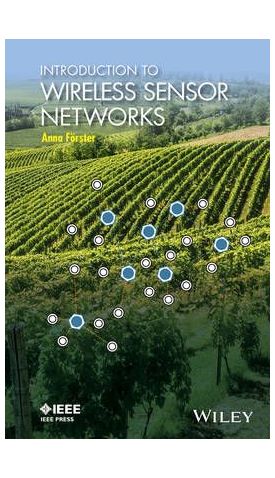אנו משתמשים ב-Cookies כדי לשפר את החוויה שלך. כדי לקיים ההנחיה החדשה של e-Privacy, עלינו לבקש את הסכמתך להגדיר את ה-Cookies. קבלת מידע נוסף.
668.00 ₪
Introduction to Wireless Sensor Networks
668.00 ₪
ISBN13
9781118993514
יצא לאור ב
New York
זמן אספקה
21 ימי עסקים
עמודים
186
פורמט
Hardback
תאריך יציאה לאור
26 באוג׳ 2016
Explores real-world wireless sensor network development, deployment, and applications * Presents state-of-the-art protocols and algorithms * Includes end-of-chapter summaries, exercises, and references * For students, there are hardware overviews, reading links, programming examples, and tests available at [website] * For Instructors, there are PowerPoint slides and solutions available at [website]
| עמודים | 186 |
|---|---|
| פורמט | Hardback |
| ISBN10 | 1118993519 |
| יצא לאור ב | New York |
| תאריך יציאה לאור | 26 באוג׳ 2016 |
| תוכן עניינים | How to Use This Book xiii 1 What are Wireless Sensor Networks? 1 1.1 Wireless Sensor Networks, 1 1.2 Sample Applications Around the World, 3 1.3 Types of Wireless Sensor Networks, 7 Summary, 10 Further Reading, 10 2 Anatomy of a Sensor Node 11 2.1 Hardware Components, 11 2.2 Power Consumption, 13 2.3 Operating Systems and Concepts, 15 2.3.1 Memory Management, 17 2.3.2 Interrupts, 23 2.3.3 Tasks, Threads, and Events, 24 2.4 Simulators, 26 2.5 Communication Stack, 28 2.5.1 Sensor Network Communication Stack, 28 2.5.2 Protocols and Algorithms, 30 Anatomy of a Sensor Node: Summary, 30 Further Reading, 30 3 Radio Communications 33 3.1 Radio Waves and Modulation/Demodulation, 33 3.2 Properties of Wireless Communications, 36 3.2.1 Interference and Noise, 37 3.2.2 Hidden Terminal Problem, 38 3.2.3 Exposed Terminal Problem, 39 3.3 Medium Access Protocols, 39 3.3.1 Design Criteria for Medium Access Protocols, 41 3.3.2 Time Division Multiple Access, 42 3.3.3 Carrier Sense Multiple Access, 45 3.3.4 Sensor MAC, 48 3.3.5 Berkeley MAC, 50 3.3.6 Optimizations of B-MAC, 51 3.3.7 Other Protocols and Trends, 51 Radio Communications: Summary, 53 Questions and Exercises, 53 Further Reading, 54 4 Link Management 57 4.1 Wireless Links Introduction, 57 4.2 Properties of Wireless Links, 59 4.2.1 Links and Geographic Distance, 59 4.2.2 Asymmetric Links, 60 4.2.3 Link Stability and Burstiness, 61 4.3 Error Control, 62 4.3.1 Backward Error Control, 62 4.3.2 Forward Error Control, 63 4.4 Naming and Addressing, 64 4.4.1 Naming, 64 4.4.2 Addressing, 65 4.4.3 Assignment of Addresses and Names, 65 4.4.4 Using Names and Addresses, 66 4.5 Link Estimation Protocols, 66 4.5.1 Design Criteria, 66 4.5.2 Link Quality Based, 67 4.5.3 Delivery Rate Based, 68 4.5.4 Passive and Active Estimators, 69 4.5.5 Collection Tree Protocol, 69 4.6 Topology Control, 71 4.6.1 Centralized Topology Control, 71 4.6.2 Distributed Topology Control, 72 Link Management: Summary, 73 Questions and Exercises, 73 Further Reading, 74 5 Multi-Hop Communications 77 5.1 Routing Basics, 77 5.2 Routing Metrics, 80 5.2.1 Location and Geographic Vicinity, 80 5.2.2 Hops, 81 5.2.3 Number of Retransmissions, 82 5.2.4 Delivery Delay, 83 5.3 Routing Protocols, 84 5.3.1 Full-Network Broadcast, 85 5.3.2 Location-Based Routing, 87 5.3.3 Directed Diffusion, 90 5.3.4 Collection Tree Protocol, 92 5.3.5 Zigbee, 94 Multi-Hop Communications: Summary, 95 Questions and Exercises, 96 Further Reading, 96 6 Data Aggregation and Clustering 99 6.1 Clustering Techniques, 99 6.1.1 Random Clustering, 101 6.1.2 Nearest Sink, 102 6.1.3 Geographic Clustering, 103 6.1.4 Clustering Summary, 104 6.2 In-Network Processing and Data Aggregation, 104 6.2.1 Compression, 104 6.2.2 Statistical Techniques, 107 6.3 Compressive Sampling, 109 Data Aggregation and Clustering: Summary, 110 Questions and Exercises, 111 Further Reading, 111 7 Time Synchronization 113 7.1 Clocks and Delay Sources, 113 7.2 Requirements and Challenges, 114 7.3 Time Synchronization Protocols, 117 7.3.1 Lightweight Tree Synchronization, 117 7.3.2 Reference Broadcast Synchronization, 118 7.3.3 NoTime Protocol, 118 Time Synchronization: Summary, 120 Questions and Exercises, 121 Further Reading, 121 8 Localization Techniques 123 8.1 Localization Challenges and Properties, 123 8.1.1 Types of Location Information, 124 8.1.2 Precision Against Accuracy, 125 8.1.3 Costs, 125 8.2 Pre-Deployment Schemes, 126 8.3 Proximity Schemes, 126 8.4 Ranging Schemes, 128 8.4.1 Triangulation, 129 8.4.2 Trilateration, 129 8.5 Range-Based Localization, 129 8.6 Range-Free Localization, 130 8.6.1 Hop-Based Localization, 130 8.6.2 Point in Triangle (PIT), 131 Localization: Summary, 132 Questions and Exercises, 133 Further Reading, 133 9 Sensing Techniques 135 9.1 Types of Sensors, 135 9.2 Sensing Coverage, 136 9.3 High-Level Sensors, 137 9.4 Special Case: The Human As a Sensor, 138 9.5 Actuators, 138 9.6 Sensor Calibration, 139 9.7 Detecting Errors, 140 Sensing Techniques: Summary, 141 Questions and Exercises, 141 10 Designing and Deploying WSN Applications 143 10.1 Early WSN Deployments, 143 10.1.1 Murphy Loves Potatoes, 144 10.1.2 Great Duck Island, 144 10.2 General Problems, 145 10.2.1 Node Problems, 146 10.2.2 Link/Path Problems, 147 10.2.3 Global Problems, 148 10.3 General Testing and Validation, 149 10.4 Requirements Analysis, 151 10.4.1 Analyzing the Environment, 151 10.4.2 Analyzing Lifetime and Energy Requirements, 153 10.4.3 Analyzing Required Data, 153 10.4.4 Analyzing User Expectations, 154 10.5 The Top-Down Design Process, 154 10.5.1 The Network, 154 10.5.2 The Node Neighborhood, 155 10.5.3 The Node, 156 10.5.4 Individual Components of the Node, 156 10.6 Bottom-Up Implementation Process, 157 10.6.1 Individual Node-Level Modules, 158 10.6.2 The Node As an Entity, 159 10.6.3 The Network As an Entity, 159 Designing and Deploying WSN Applications: Summary, 160 Further Reading, 160 11 Summary and Outlook 163 Index 167 |
| זמן אספקה | 21 ימי עסקים |



Login and Registration Form